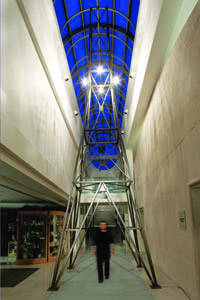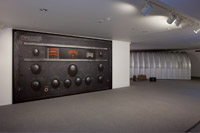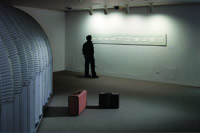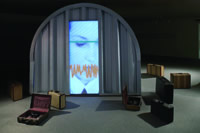 |
Radio Tower 1
Steel, lights, relay electronics
10.5 m x 2.7 m x 2.7 m (34’10” x 9’ x 9’) |
| |
 |
Camp X Radio
UV inkjet print on canvas
2.7 m x 4.5 m (108” x 188”)
|
| |
 |
Correspondence with David White
2 digital ink jet prints
43 cm x 3.38 m (17” x 133”) |
| |
 |
Quonset Hut (Women’s Royal Navy Service)
Galvanized aluminum, white Plexiglas door, 3 video projectors, Apple computer running MAX/MSP interactive software, 8 vintage suitcases with custom-built electronics, audio speakers. |
| |
|
|
Installation description
Relay (2008)
Entering the main foyer of the gallery, viewers are greeted by a 35-foot high steel radio tower that reaches the top of the barrel-vaulted skylight of the atrium.
In the main gallery of the exhibition is a mural-size photograph of the controls of a radio from Camp X. Nearby, a scroll-length photograph reproduces email correspondence between the artist and one of the last surviving radio operators in England who transmitted to "Hydra," in which he describes Camp X and women’s roles in radio communication. In the same room is a large aluminum Quonset hut containing a video projection of a British navy recruiting film that can be seen through the door and peep holes in the sides.
Picking up a vintage suitcase near the hut, a viewer hears a Morse code message from a tiny speaker embedded in the case. Opening the suitcase transmits a waveform of the code, first to the Quonset hut screen, and then sends the code to an adjoining room where a series of pulsing lights on three radio towers enact the flow of information between England, Camp X and the US.
At the same time, the radio towers are relaying these messages to a computer that translates the code into plain text. The deciphered information then appears in teletype on a large screen interspersed with photographs of military women. This interactions only occur while a suitcase remains open. As soon the case is closed, the ability to send and decode information stops. This “blind” sending and receiving of messages echoes the nature of radio communications during
the war.
<<< more about RELAY >>
back to artwork
|
